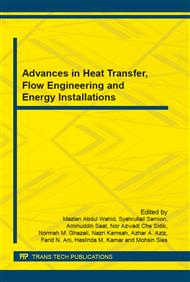[1]
B. Tuckerman and R. F. W. Pease, High-performance heat sinking for VLSI, IEEE Electron Device Letters, EDL-2 No. 5 (1981) 126-9.
DOI: 10.1109/edl.1981.25367
Google Scholar
[2]
N. Goldberg, Narrow channel forced air heat sink, IEEE Trans. Comp. Hybrids Manuf. Technol., CHMT-7 (1984) 154-159.
DOI: 10.1109/tchmt.1984.1136326
Google Scholar
[3]
M. Mahalingam, Thermal management in semiconductor device packaging, Proc. IEEE. 73 (1985) 1396-1404.
DOI: 10.1109/proc.1985.13300
Google Scholar
[4]
G.A. Quadir, A. Mydin, and K.N. Seetharamu, Analysis of microchannel heat Exchangers using FEM, International Journal of Numerical Methods for Heat Fluid Flow, 11No. 1(2000) 59-76.
DOI: 10.1108/09615530110364097
Google Scholar
[5]
Qu, W. and I. Mudawar , Analysis of three-dimensional heat transfer in micro channel heat sinks, International Journal Heat and Mass Transfer, 45 (2002) 3973–85.
DOI: 10.1016/s0017-9310(02)00101-1
Google Scholar
[6]
B.D. Shao, L.F. Wang, Li. Jianyun and H. M Cheng. (2013), Multi-objective optimization design of multi-layer rectangle micro-channel heat sink for single-phase flow and heat transfer, Advance Materials Research, 709 (2013) 286-291.
DOI: 10.4028/www.scientific.net/amr.709.286
Google Scholar
[7]
B. D Shao, L.F. Wang, Li Jianyun and Z.W. Sun, Application of thermal resistance network model in optimization design of micro-channel cooling heat sink, International Journal of Numerical Methods for Heat Fluid Flow, 19 (2009) 535–45.
DOI: 10.1108/09615530910938425
Google Scholar
[8]
S.G. Kandlikar and W.J. Grande , Evaluation of single phase flow in micro channels for high flux chip cooling , Thermo hydraulic performance enhancement and fabrication technology, Heat Transfer Engineering, 25 (2004 ) 5-16.
DOI: 10.1080/01457630490519772
Google Scholar
[9]
D. Liu and S.V. Garimella , Analysis and optimization of the thermal performance of micro channel heat sinks, Intern. Journ. of Numerical Methods for Heat & Fluid Flow, 15 (2005)7-26.
DOI: 10.1108/09615530510571921
Google Scholar
[10]
K. Vafai and L. Zhu, Analysis of two-layered micro-channel heat sink concept in electronic cooling, International Journal of Heat and Mass Transfer, 42 (1999 ) 2287-2297.
DOI: 10.1016/s0017-9310(98)00017-9
Google Scholar
[11]
P. Skandakumaran, A. Ortega, T. Jamal-Eddine , Multi-layered SiC microchannel heat sink-modeling and experiment, International Society Conference on Thermal Phenomena, (2004)352-60.
DOI: 10.1109/itherm.2004.1319196
Google Scholar
[12]
M.L. Levac, H.M. Soliman, and S.J. Ormiston, Three-dimensional analysis of fluid flow and heat transfer in single- and two-layered micro-channel heat sinks, Heat and Mass Transfer, 47 (2011) 1375-83.
DOI: 10.1007/s00231-011-0795-7
Google Scholar
[13]
B.D. Shao, L.F. Wang, Li. Jianyun and H. M Cheng, Optimization and Numerical Simulation of Multi-layer Micro channel Heat Sink", Procedia Engineering 31(2012) 928 – 933.
DOI: 10.1016/j.proeng.2012.01.1123
Google Scholar
[14]
X. J. Wei and Y. Joshi, Optimization Study of Stacked micro-Channel Heat Sinks for Micro-Electronic Cooling, IEEE Transactions on Components and Packaging Technologies, 26(2003) No. 1.
DOI: 10.1109/tcapt.2003.811473
Google Scholar
[15]
X.J. Wei and Y. Joshi , Stacked Micro channel Heat Sinks for Liquid Cooling of Microelectronic Components, Journal of Electronic Packaging, Transactions of the ASME, 126 (2004).
DOI: 10.1115/1.1647124
Google Scholar
[16]
B. D Shao, Z.W. Sun, and L.F. Wang, Optimization design of micro channel cooling heat sink, International Journal of Numerical Methods for Heat & Fluid Flow, 17 (2007) 628-37.
DOI: 10.1108/09615530710761243
Google Scholar
[17]
N. Lei, P. Skandakumaran, A. Ortega, Experiments and Modeling of Multilayer Copper Mini channel Heat Sinks in Single-Phase Flow, IEEE (2006).
DOI: 10.1109/itherm.2006.1645318
Google Scholar


